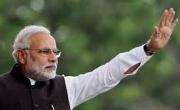Luck and Courage Move India Forward
(FROM BARRON'S 11/3/14)
By Craig Mellow
A combination of good luck and courage has rekindled economists’ optimism about India just as the halo surrounding Narendra Modi, its new, purportedly pro-business prime minister, is beginning to fade. Good luck has come in the form of diving oil prices, which are easing the import burden that placed India on Morgan Stanley’s “fragile five” list of particularly troubled emerging markets last year. The courage is Modi’s. He took advantage of the price cut to eliminate diesel-fuel subsidies and raise regulated natural-gas prices by a third, saving India’s beleaguered budget close to 1% of gross domestic product and untangling a major market distortion.
Modi may still not have delivered enough to lift India’s stock markets higher right away. The benchmark Sensex Index has already climbed by 30% since the prime minister, who gained prominence overseeing a so-called economic miracle as governor of Gujarat state, started looking like a national winner in March (“India: Open for Business,” May 5). Companies traded on India’s Sensex index already boast an average price/earnings ratio of 17.4 times 2014 estimates, compared with 11.4 for Brazilian shares, 9.5 for stocks in Shanghai, and 4.7 for woebegone Russia. So a fair bit of reform success is already priced in.
Still, the World Bank was impressed. “As economic reforms gain momentum, India’s growth is likely to accelerate toward its high long-run potential,” the mandarins wrote in their latest economic brief. Private-sector analysts largely agree. A Reuters poll of 20 economists yielded average growth expectations of 5.5% this year and 6.4% in 2015, compared with 4.7% last year. Inflation is easing from almost 11% in 2013 to expectations of about 7% this year and next.
Unlike in China, which is struggling to shift from manufacturing to a more consumer-oriented economy, India’s progress depends on strengthening uncompetitive factories, which generate just 16% of GDP, compared with more than 20% in most emerging markets. Unleashing industry will require changes that strike at the roots of India’s socialistic and decentralized social order. At the top of the World Bank’s wish list is a national “goods and services tax,” which despite the mundane name would transform India into a common economic space for the first time, dismantling red-tape happy border posts at its 37 states and territories.
Modi and his Bharatiya Janata Party, which controls the lower but not upper house of parliament, will also have to revamp laws that restrict hiring and firing employees and encumber the acquisition of land for new facilities, says Shilan Shah, India economist at Capital Economics in London. These shifts will gore the ox of powerful trade-union and small-farmer lobbies, not to mention state governments, most of which are not in the BJP’s hands. These entrenched interests are likely to prevail, disillusioning investors in time, Shah predicts. “Our view is that the government might fall short of expectations, and the market may struggle to make further gains.”
At least Modi is trying hard to push his country in a positive direction. That alone makes India an oasis among the BRIC markets. Brazil and Russia are rallying around leaders who are moving resolutely in the wrong direction, as far as world markets are concerned, while China sends mixed, opaque signals about its own promised reforms and seems resigned to economic slowdown.
“It appears that Modi is playing the long game,” says K. Sudhir, an Indian-born professor at the Yale School of Management. “The diesel-subsidy removal shows that he is ready to take the right action when the opportunity presents itself.” But emerging-market investors are not known for long-game patience.
—


